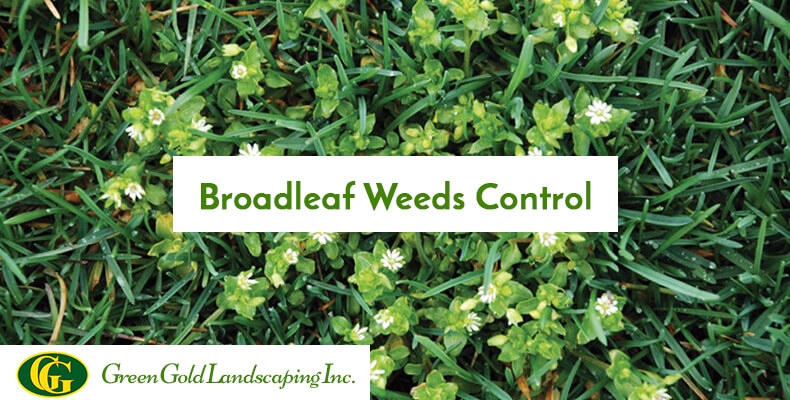17 Sep
Broadleaf Weeds Control
Posted By Ervin in Gardening
The most troublesome weed plants for any lawn are the dandelions and other broadleaf weeds. Even the control of these weeds is easy, and it is not possible to completely eradicate them. Improper or untimely use of fertilizers and over or under watering of lawns encourages the growth of weeds.
Where Do These Broadleaf Weeds Come From?
- Most of the broadleaf plants produce thousands of seeds, and these seeds are spread fast through the air to other parts of your lawns from miles away.
- Poor quality or inexpensive varieties of grass seeds can also have the seeds of these weed plants included.
- You can find most of the seeds of broadleaf seeds in topsoil brought to the lawns.
We have here highlighted the most critical steps of the broadleaf weeds control in the lawns.
1. Identifying the Weed Life Cycle
The first and foremost step is to understand the life cycle of the broadleaf weed. The weeds are divided into groups as annuals, biennials, and perennials according to their life cycles.
Annuals: These type of weeds germinate, grow and die in less than 12 months. Further classified into winter and summer annuals. Winter annuals germinate in the fall and thrive in the spring and die in the summer. Summer annuals germinate in the spring, grow in the summer and die in the fall season.
Biennials: These weeds will germinate from the seed and live for two years. They store the food in the roots for the first year and go for blossoming in the second year.
Perennials are those weeds that live for more than two years. They can reproduce from the seeds and also from the vegetative structures like the roots, bulbs, and tubers. This ability makes them more vulnerable and difficult to control.
2. Best Time for Broadleaf Weeds Control
The best time to apply the broadleaf herbicide is from mid-September to early November. To control the weeds such as dandelions, plantain, and clover fall is the best time. In the winter season, the plants will be storing the food reserves in stems and roots. So when the herbicide is applied, it goes straight into the reserves and kills the weed. The second best time is the late spring or the early summer. If you are going for the late spring application, then be careful not to apply these herbicides near to the ornamental plants, as they can be damaged.
Some points to remember while using the herbicides
- Use the herbicides preferably on the fully grown or young weed plants.
- Do not apply the herbicide when the soil moisture is low, it not only reduces the effectiveness of the medicine but also damages the turfgrass.
- Always apply when the climate is clear and temperature below 50.
- If by chance rain pours down after the application, then re-apply the herbicide after 10 days.
- Do not apply the herbicide on the newly sodded areas.
- Delay the application of the herbicide if the grass not mowed at least three times.
- Delay the mowing before and after application of the herbicides.
- If bare spots are formed after the removal of weeds, then seeding can be done after good soaking in the rain or irrigation.
3. Selection of the Herbicide
The most crucial factor in controlling the weeds is the selection of the right herbicide. Most of them work on a set of weeds but not on all the broadleaf weeds. Phenoxy herbicides specifically work to control broadleaf weeds. You can check out with a Professional lawn maintenance expert to help you find the right herbicide for the weed that is the most problematic in your lawn.
4. Water Quality
The quality of water is also vital in the weed control. The water quality has an impact on how the herbicide works on the weeds. Most of the herbicides do not work correctly if the water contains too much calcium and the same work effectively when the water is conditioned using ammonium sulfate.
5. Summer Annual Broadleaf Weed Control
Summer annual broadleaf weeds are tough to control, as there is different germination period for various species present in the plants. Most of the plants have a short mature period, and by the time you have noticed them, the seeds would have distributed. Another reason for not able to control them is that they have a wax coating on them to minimize the water loss, this property does not allow the herbicide to get into the layers of the leaves. A single herbicide is not enough to control various species of the weeds present.
Use a herbicide containing isoxaben in April, that controls the weeds at the time of germination. Combine it with a post-emergent herbicide containing 2,4-D to control already germinated weeds.
Application of single herbicide in the late May might help in the reduction of weeds. Consult a Professional to know the proper cultural practices in controlling the weeds.
Conclusion
In summary, you should understand the weed life cycle to control them. The selection of right herbicides with good quality of water plays a vital role in regulating the weeds. Fleas can also be controlled by destroying the weeds in the lawn. For more suggestions and help with weed control, contact Green Gold Landscaping Inc at 914-882-5459. We offer professional landscape, lawn and snow removal services for residential and commercial properties in Westchester County and Greenwich CT, New York.









